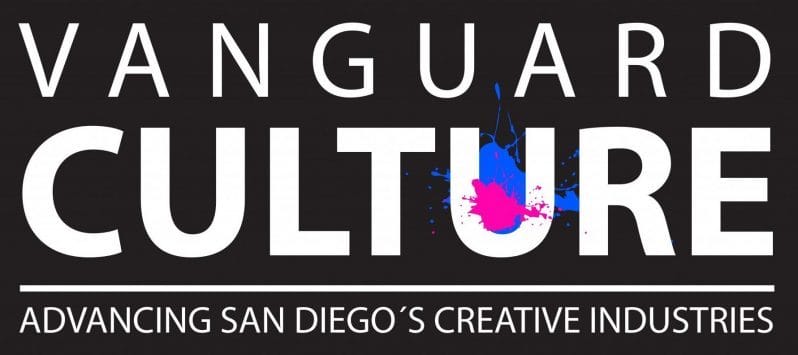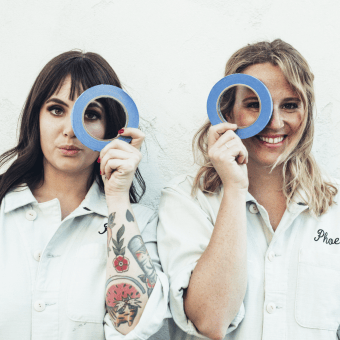Article by Mario Sanguinet
March 1, 2020
It would be almost impossible to live in San Diego and not be familiar with their murals. Maybe you have seen their artwork scrolling through your Instagram or Facebook feed. Perhaps your interaction with their paintings was not in the virtual realm but in the physical one. You might even have a picture with one of their murals in the background.
Better yet, you have probably driven past one of the murals they painted.
If you have been to Liberty Station, you might recall a Zen-like-reminder that “You Are Exactly Where You Need To Be.” (This mural has since moved a couple of hundred feet over from the Truxtun Road entrance to a wall on Sims Road, directly across from the Public Market.)
Maybe you got the cheerful nudge to “Smile, [because] you’re in San Diego,” as you drove through Downtown.
While you may not personally know Roxy Prima and Phoebe Cornog, you might want to thank them, since they are responsible for painting these uplifting prompts.
Prima and Cornog are the co-founders and co-directors of Pandr Design Co., an art studio/design agency dedicated to creating memorable moments through murals and art. But they do more than that.
In 2019, they started Ladies Who Paint, their non-profit focused on giving female artists and muralists a platform to show their work.
If that were not enough, they have been hosting the podcast Drunk on Lettering since 2016, recording over 150 episodes. On the podcast Prima and Cornog, along with their producer, drink wine, eat cheese and discuss the latest design trends or talk with other artists and designers in the field.
Courtesy of Mario Sanguinet
As co-founders of Pandr Design Co., they have done something as small as live lettering on shirts, for Bumble (yes, that Bumble) to creating custom art pieces for tourism boards and agencies to installations the MLB, NBA, and NFL to painting multiple 1,000+ square foot murals, a few of which are here in San Diego.
So far, they have worked on over 130 murals, both nationally and internationally. And they are just getting started. Almost literally, since Pandr Design Co. is only a couple of years old and they have already achieved so much. Yet, there is much more in store for them.
This past December, I met up with them in Pandr Design Co. headquarters, a delightfully rezoned home in North Park, which they have since redecorated to become their office. To the best of my ability, I wanted to capture their story as people and businesswomen. How it began, where it has led them, what their ups and downs have been and where they see this journey taking them.
This is what I found out…
Step 1: School’s Out
The narrative arc of Prima and Cornog’s stories is slightly different, but they share similar beats. Both had somewhat of a start-stop college experience, but eventually found their way, which meant forging their own path.
For Prima, a native San Diegan, it started with an uncharted journey through college at Gonzaga in Spokane, Wash. It “definitely took me a while to figure out what I wanted to do as a career. In high school, I had no idea what design was,” recalled Prima.
Add a boundless sense of possibilities, which school presented, to the uncertainty of knowing different career paths and it all led to Prima being unable to pick a major. “I was basically taking every kind of class. And then I ended up dropping out after two and a half years,” said Prima. None of which pleased her parents.
After this Prima came back to San Diego and enrolled in a community college where she took a design class. This eventually led her to pursue “design school, which I then dropped out of after two and a half years, my lucky number,” joked Prima.
By that point, Prima had been in college for close to seven years, felt burnt out and in need of a full-time job. She had all she needed “to build a foundation for a design career.” And since she always knew she wanted to work for herself, not having a degree did not bother her.
On the other hand, Cornog, a Philadelphia native, had a clearer picture of her path. “I always knew I wanted to go to art school. So, I was prepping for that,” throughout high school, recalled Cornog. This clear goal, however, did not spare for from facing bumps along the way.
As Cornog wrote in the caption of one of her Instagram posts, she had her sights on attending Rhode Island School of Design, which did not go her way. When we spoke Cornog told me she enrolled at Pratt Institute in Brooklyn, New York, “because I wanted to get out of Philly and New York seemed cool.”
But as great as New York was for Cornog, she “didn’t consider the social aspect of college. So going to a full-on arts school with 2,000 [students]… wasn’t the best fit for the captain of the swim team Phoebe Cornog.”
So, after two years in New York, she was ready to transfer. Once again, she tried the Rhode Island School of Design, to no avail. Instead, she got accepted into the Tyler School of Art at Temple University, which she was not initially thrilled by since it was 15 minutes from where she grew up in Philadelphia. Fortunately, it all worked out because she graduated in 2013 and promptly moved to San Diego.
Step 2: Do it for the ‘gram
Social media gets a lot of heat, often it is warranted. Yet, on rare occasions, it has its redeemable moments. The meeting of Prima and Cornog might be one of them. After all, it all started with a DM (direct message) on Instagram…
In 2012, early on in Instagram’s life (the site launched in 2010), Prima saw the site as a way of showing and sharing her work. She was posting lettering and drawings every day and began to build her online following. Eventually “more people were seeing my work and then people would say, ‘Can I buy this from you?’, ‘Can you design my logo?’” that was when Prima also saw the platform’s business potential.
One of those people seeing Prima’s work, Phoebe Cornog.
Cornog, already moved and settled in San Diego, was working in the action sports industry and was not feeling particularly challenged, which is how she, “found [herself] on Instagram a lot and looking to idols like Roxy.” Soon enough, Cornog “reached out to Roxy one day, asked if she wanted to grab drinks. Not thinking she would respond. But she did and we met up and we started San Diego Letters.”
San Diego Letters was a lettering club, “Yes, that’s a thing!” laughed Cornog. “A club for lettering nerds and people who wanna just hang out and do creative stuff.” This creative outlet inadvertently became the testing ground of Prima and Cornog’s relationship as they soon realized they worked well together. About a year after the club began, San Diego Letters became Pandr Design Co. and they had officially gone into business together.
None of this would have been possible, were it not for social media. And Prima readily admits their online presence “has definitely been a big foundation for Pandr Design Co.” But she goes on further by saying, “Instagram is how we got our start and how we continue to get a lot of our clients.”
And if their Instagram follower count is any indication of how much people like their work, then they might just be fine. At the time of this writing, Cornog’s follower count is slightly over 22,500 (@phoebecornog); Pandr Design Co. has close to 24,000 followers (@pandrdesignco); and Prima has a little over 38,000 followers to her credit (@roxyprima).
Step 3: #NoFilter
Prima and Cornog use all three of their accounts, both of their personal ones and their business one, to “break the fourth wall.” This term, “breaking the fourth wall,” usually refers to the performing arts, like when an actress speaks directly to the audience. In doing so the actress shatters the illusion and previously held beliefs of how a performance is to be conducted.
A slightly self-referential post on Prima’s account features a picture of a mural that reads, “DON’T FORGET THIS IS JUST A HIGHLIGHT REEL.” In the caption, she wrote, “It’s easy to forget, but we gotta realize [Instagram] is just the highlight reel. Stop comparing yourselves to other people’s Insta-lives!”
If someone were to follow any of their accounts on Instagram, they would get aesthetically pleasing art, to be sure. But they would also get business suggestions, inspirational art and the occasional reminder that they are “not always slaying it.”
Courtesy of Pandr Design Co.
Courtesy of Pandr Design Co.
Some of these humble reminders are personal, like Prima’s caption about a negative podcast review that gnawed at her. Or Cornog’s caption featuring “three fails.”
Prima and Cornog “break the fourth wall” and use their large following to undermine the unwritten conventions of how things should be conducted in social media. But when they do so it is not done in an attention-seeking manner. Rather, it is an active attempt to remind their followers that, as beautiful as things might seem on Prima’s, Cornog’s or Pandr Design Co.’s, feeds, things are not always that great. While also providing their followers with some useful suggestions.
Step 4: Miss. Behave.
The first time I saw Prima and Cornog was in July 2019. They were dressed in their painting clothes. I was walking westward on F Street in East Village on my way to meet the director of this organization/ Vanguard Culture (also, for the first time).
As I walked past them, on a sidewalk partially covered in drop cloths, I saw a half-painted wall. I was unsure what these two young women were doing. For a split second, I thought they were vandalizing a wall. Not proud of this snap judgment.
Alas, I was relieved to know they were actually painting a mural. This revelation would take a moment and probably came to me as I walked back to my car and saw a little more than a half-painted wall. Regardless, I look back at this moment fondly not because I misjudged two women at work. No, rather, I got the rare opportunity to see something as it was being created. Even if my initial thought was that of a pair of rebels.
Courtesy of Pandr Design Co.
Yet, that is exactly what Prima and Cornog are, rebels. Not disparagingly, but literally. After all, being creative means, “We do things in our own way” as Prima noted, “we’re always brainstorming and coming up with our own ideas and creating our own path.” And a rebel is someone who goes against conventional norms and finds a way to do things differently.
Prima and Cornog are rebels because they are pushing against the unhealthy stereotype of the starving artist; they gave a TEDx talk about this in May 2019.
Prima and Cornog are rebels because they are unafraid to talk about money and encourage other artists to do the same; a recurring theme on their podcast, Drunk on Lettering as well as their webinars.
Prima and Cornog are rebels because, well, it is almost inherently rebellious to go out and paint walls, which virtually goes against everything our parents taught us.
After all, they see “spaces differently than other people and [are] able to create something out of nothing,” as Cornog mentions. They “see a wall and just immediately visualize awesome things to put on top of it.”
So, yes, Prima and Cornog are rebels.
Step 5: Art. Supplies. Bristles.
Prima and Cornog attribute a large portion of their success to having a system that reduces uncertainty for themselves and for the client. To a large extent, this is really about having strong project management skills.
“Clients need to know exactly when they’re getting designs [and] when the mural is getting installed,” Prima mentioned. So Prima, Cornog and Erica Snider (Pandr Design Co’s business and marketing manager) have to know what is due, when and for whom so they can deliver it on time.
This level of detail and organization is what “sets us apart from other artists [because] they don’t know how to” manage a project, noted Prima. “A lot of artists just don’t think that way and don’t want to do it that way.”
The added benefit of these project management skills is that it allows Pandr Design Co. to know what their workload is and if they need to be taking on more projects or if they have taken on too much.
Even then, project management skills can only carry them so far, because the challenges of painting murals come in many different ways, shapes and sizes. Ranging from difficult clients, who may have unrealistic expectations. Like one who wanted more of a life-size ad than a mural, which was prohibited by the local jurisdiction. To the client who was breaching their contract and lawyers had to get involved. To clients who did not pay for services rendered.
At times clients want murals in peculiar locations, like a staircase or inside a parking garage, both of which have distinctive scents. None of which are olfactory pleasing. Or perhaps the graveyard shifts, of which they have worked their fair share of, painting in the dead of night until the break of dawn.
Other times the clients are great but the weather is inclement. Like the time they had to paint a mural in Philadelphia in early March, where they felt their fingers might freeze off.
Despite the challenges they have faced over the years, both Prima and Cornog love the novelty of each new project. “We’re always working with a different company, in a different industry and new things are coming up all the time,” said Prima. “So, it’s like there’s not this mundane, boring, repetitive thing in our business. It’s always something different. It’s always something exciting.”
Step 6: Paint. Brush. Tips.
More revelatory, however, were the five inadvertent business tips they shared throughout the interview. They are as follows…
Inadvertent Business Tip #1
Avoid working with or for your friends and family.
We live in a world simultaneously governed by social norms and market norms.
Social norms are the favors we trade with one another in hopes of strengthening our relationships. Like, asking a friend for a ride to the airport. Market norms, on the other hand, are usually interactions involving the acquisition of goods or services in exchange for money. Like, ordering and paying for lunch at a restaurant.
Both of these are separate tracts and all is well when they stay in their lanes. Things get messy, however, when social and market norms merge. That is exactly what happens when family or friends ask for a logo, website or design. Social norms dictate we do this because it will strengthen the relationship. Yet, market norms, dictate we charge them for the service since it is how an artist or designers make a living. But, doing both usually does not bode well.
As Cornog put it, “You always think, like, ‘what’s the lowest I could charge?’ [or] ‘what would I pay?’ you’re not supposed to think that way. It’s not ‘would I pay $200 for this?’… [stop] trying to give your friends and family a deal. So now we say, ‘Never work with friends or family… It gets too awkward.’”
Inadvertent Business Tip #2
Reduce uncertainty for you and the client by having a set process and timeline.
As Uncertainty Reduction theory states people like to know what to do or what to expect in new situations. Or as Prima mentioned, “Clients need to know exactly when they’re getting designs [and] when the mural is getting installed.” So, having a contract and timeline where deadlines are specified makes sure everyone is in agreement with expectations.
The contract will outline the scope of work that you and the client have agreed upon. This will reduce uncertainty for you since your client, ideally, will not add more work at the eleventh hour. So you and the client have an assurance of what you are expected to create.
The deadlines ensure you will produce certain deliverables by a given date. Doing so allows the client to know what to expect and by when.
And just as important, how and when you will receive payment, which leads to the next point.
Inadvertent Business Tip #3
First, cash the check. Then, do the work.
“We’ve been burned,” recalled Cornog. So now they, “Do not do any design work until the contract is signed and the check is received.”
As many an artist can attest, it is disheartening to create and deliver work only to not be compensated. To avoid this, make it abundantly clear to the client that no work will begin until the bank has cleared the payment. This could even be part of the standard contract language that was signed (see previous point).
To be clear, the check cannot be “on its way” or “in the mail.” Only start working until payment is received and in your bank account.
Inadvertent Business Tip #4
Present as much of a finished product as possible.
“Sketches freak clients out,” said Cornog. Avoid putting yourself in a negative position and try to show completed work as often as you can.
Or take Prima’s word for it, “There’s no one who is gonna see [a sketch] and be like, ‘Wow! That’s so cool!’” Do your best present something that closely resembles the finished product. This might take slightly longer, but it will be much easier for the client to properly see the vision and thus might need less convincing on why your idea is a good one.
Step 7: Find the Right Space
Occasionally when commissioned to paint a mural Prima and Cornog have to scout locations best suited for the task at hand. And in a way, this sums up their journey so far: the search for the right space.
If one was to reduce the experiences of Prima and Cornog to a sentence, that would be it, the search to find the right space for their work.
In a way that is what both have been looking for, and continue to look for, the right space. The right space academically. The right space to channel their creative energies. The right space to support and encourage women. The right space to work and for their work.
Often those spaces did not exist, so they went ahead and created them. That led them to start San Diego Letters, a place where they could thrive creatively. This led to Pandr Design Co., a place where they could thrive professionally. And ultimately, that led them to launch Ladies Who Paint, a place where they could support female artists.
Part of being the human experience is the search for a place, space or group where we belong. And both Roxy Prima and Phoebe Cornog can tell you, sometimes you have to create your own way. It will not always be easy. It will not always work out. It will not always be fun or great.
But, occasionally you will have a moment of clarity when things click, when all the right pieces fall into place and you achieve what you set out to do. And it is those instances, where you should pause and take a moment and celebrate the wins. Because at the end of it all, life is just a collection of moments, fragments of time stitched together and if you do not pause to take them in, who will?
That, was the last inadvertent business tip I got. And you will not see it on a mural or an Instagram post. At least, not yet.



